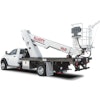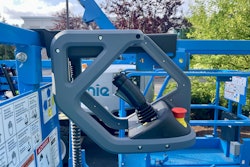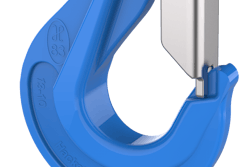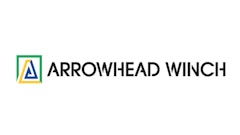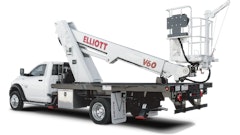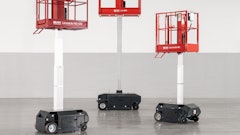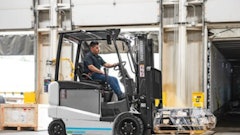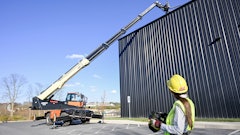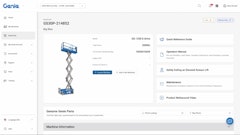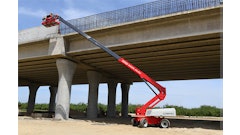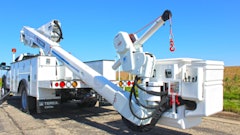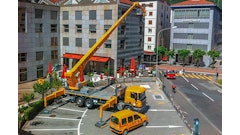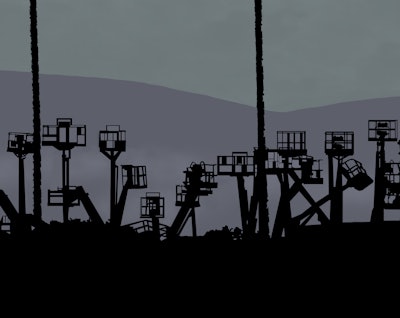
The International Powered Access Federation (IPAF) published its 2025 Rental Market Reports, featuring expert insight into the mobile elevated work platform (MEWP) rental markets across North America, Europe, and Asia.
In 2024, the North American MEWP rental market experienced a notable shift, as its high-growth cycle ended, according to the latest analysis conducted for IPAF by Ducker Carlisle.
Faced with mounting cost pressures, a slowdown in construction investment amid high interest rates, and general uncertainty, most key indicators failed to register growth. Revenue increased by just 1 percent year-on-year to $15.2 billion, signalling a plateau following three years of rapid expansion. A subdued final quarter, coupled with high interest rates, rising material costs, and broader economic uncertainty, weighed heavily on the market.
Fleet growth halted, with the total MEWP fleet holding steady at around 857,000 units — marking the first year without net expansion. Projections suggest the fleet will stay near this level for the foreseeable future, with a marginal increase of around 500 units anticipated in 2025. Utilization declined to 71 percent, returning to more typical levels after the overheated conditions of 2023.
Rental rates rose by only 1 percent, and companies prioritized utilization and cash flow over price increases. Investment also dropped significantly, falling from 13 percent growth in 2023 to just 5% in 2024, with firms shifting toward fleet renewal and more cautious planning. As the market enters a correction phase, only modest rental rate growth and limited fleet expansion are forecast over the next two years.
Cross hire activity decreased further in 2024, with current levels particularly low. While the overall need for cross hire has declined in some areas following years of fleet expansion, it remains a consistent feature of the US market. Several companies operate with a dedicated re-rental model, supplying equipment for long-term projects, specialized high-cost MEWPs with limited local demand, or to support rental firms with constrained financing.
By way of comparison, the European fleet stood at a total of approximately 365,000 units at the end of 2024. In 2024, rental companies reduced purchasing activity amid shorter lead times, market saturation in larger countries, and uncertainty in the construction sector. France’s fleet remained flat, the UK’s contracted by 2 percent, while growth in Italy and the Netherlands also slowed.
Euan Youdale, Editor of Access International magazine, writes in his expert commentary:
While growth is expected to continue in the USA rental market, it is slowing. So says the American Rental Association (ARA) in its updated forecast, released in May. Although there will be positive growth in 2025, it will be tempered by uncertainty due to potential changes in government policy under President Donald Trump’s administration, including tariffs.
“[The rental sector] is positive and we don’t have any kind of a boom bust scenario, but there’s a lot of uncertainty out there which is triggering a lot of wait and see,” said Scott Hazelton, Managing Director at S&P Global, which provides forecasts for the ARA.
That said, general rental is set to do better than other sectors, Hazelton comments, “Rental businesses thrive in uncertainty, because if you’re a contractor and you get a job, and you need a machine for that job, do you really want to spend the money right now for a five- or six-year investment that you’re not sure you’re going to need in two years?”
A report from Off-Highway Research into the construction sector supports this. Equipment sales in North America were down 5 percent last year, although it was a shallower decline than was previously expected. The report found that after three consecutive years of record high sales from 2021 to 2023.
“This year’s anticipated 11 percent decline in sales reflects not only the on-going return to normal sales volumes, but also the damage to business confidence being done by the Trump administration’s inflationary import tariffs and the unpredictability of its policy making,” added the report.
With continued uncertainty around President Donald Trump’s tariffs, some manufacturers have vowed to expand manufacturing in the USA to avoid potential future rises. In April, UK-based OEM JCB said that it will double the size of a new 500,000-square-feet factor factory currently under construction in Texas to one million square feet.
Chinese manufacturers are also looking at options to avoid the tariffs, including those imposed specifically on MEWPs imported from China by the US government’s International Trade Committee (ITC) in 2023.
One example came with Dingli’s acquisition of US distributor MEC in 2023, after having a minority ownership of the manufacturer, previous to that. Now, Zoomlion Access, which already has a factory in Mexico, is considering a new plant in the USA or buying an existing MEWP manufacturer there. General manager Ren Huili, said, “We always wanted a factory in the USA. We are now talking with manufacturing facilities to buy anyd existing brands which we could acquire.”
Even in a highly competitive MEWP environment, there are new entrants to the sector. China-based Infore Environmental Technology, best known for being China’s largest manufacturer of garbage trucks and related products, has turned its attention to access, with the acquisition of a major manufacturer in the US being a serious consideration, the company told Access Briefing.
Those OEMs already based in the USA are seeing the benefit of local production. John Pfeifer, president of JLG’s parent company Oshkosh said, “Nearly all of what we sell in the United States is built in the United States…which we believe puts us in a strong competitive position in our industries.”
 International Powered Access Federation
International Powered Access Federation
Nevertheless, OEMs headquartered in the USA like JLG and Genie reported declines in their latest financial results. JLG’s first quarter 2025 sales fell 22.7 percent to $957.1 million, compared to the same period in 2024.
Peter Douglas, CEO and Managing Director of IPAF, said:
The indicators, trends, and forecasts featured in these reports offer essential insights for anyone operating in the powered access market – not only rental companies, but also equipment manufacturers, suppliers, and investors. They provide the data needed to make informed decisions on investment planning, strategic growth, and overall business direction. Don't miss this opportunity to access the latest market intelligence in the powered access industry.
For detailed analysis of the North American, European and Asian markets, the 2025 IPAF Rental Market Reports are available now.
IPAF manufacturer, supplier, distributor and rental company members can apply for a free copy of the relevant report by filling in the form at www.ipaf.org/reports; non-members are able to purchase the report.

